
ENTERPRISE ARCHITECTURE INFORMATION DAY JAN 16TH 2020
There was a large attendance at the recent Information Day held by the Enterprise Architecture team held at the Gartner Offices, Dublin 2 on the 16th January 2020. Enterprise Architecture is responsible for supporting the strategic development of technical architecture, technology and operational capabilities in a standardised and aligned manner.

Peter Connolly Head of Enterprise Architecture & The Design Authority began proceedings by outlining the objectives of the Enterprise Architecture Information Day which was to ensure that attendees were brought up to speed in terms of all advancements made in the work being carried out throughout the year, a look at some of the processes implemented and also an outline of where Enterprise Architecture are moving to in terms of dealing with architecture.
A core objective of the day was to understand where Enterprise Architecture is leading out on and what it means in terms of resources and the support the team can provide to the grater OoCIO and HSE Staff.
The day was broken into 3 stages
- A series of short presentations followed by a Q&A session
- New capabilities within Enterprise Architecture followed by a Q&A session
- A walkthrough of a Project Lifecycle providing examples of how EA tools and skillsets are provided
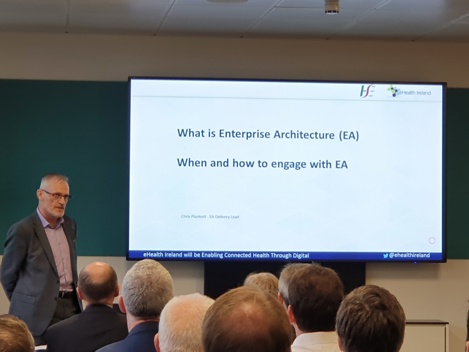
Chris Plunkett EA Delivery Manager
Chris presented on what, when and how to engage with Enterprise Architecture (EA), a central service with a focus on unifying ICT. Enterprise Architecture takes an enterprise wide ‘end to end’ collective approach to solutions, rather than one solution to one problem. The approach is broken down to 2 levels, strategic and tactical, with the former looking at the enterprise as a whole and the latter taking a more in depth look at the 'on the ground' systems approach. The goal is to create a unified ICT environment with a focus on the OoCIO strategic approach and goal of ‘lead with architecture’
Chris discussed how Enterprise Architecture look at areas such as, how do businesses do their business, Clinical Terminology and the need for coding clinical data), plus, vendor and solution integration testing and certification. The presentation also discussed the Data Dictionary and what data means in particular to the HSE, how it is interpreted and how it is defined in solutions. Data Compliance of systems and services was another area for discussion. Chris concluded with an overview of some of the projects and solutions that EA have worked with to date and advised an attentive audience to simply 'engage'.
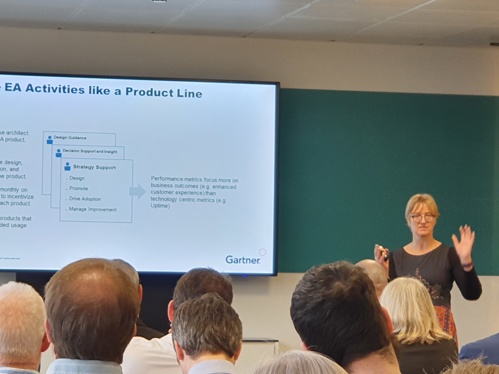
Caroline Barnsdall - Thompson Vice President Enterprise Architecture and Innovation IT Gartner
Caroline travelled from the UK to present on Product Models while discussing their benefits and exemplers. With a background in coding and IT Caroline now works with clients from all across Europe on Enterprise Architecture and how to develop Enterprise Architecture. Caroline explained about 'Product' a new trending word, what is this Product that we talk about, why is it suddenly relevant to the IT Industry and specifically why does it work well within Enterprise Architecture
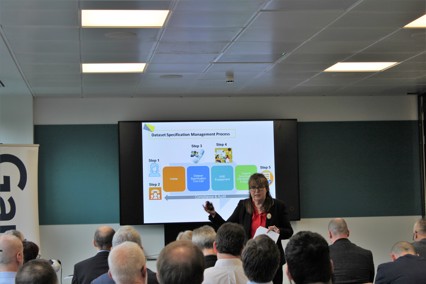
Helen Lambert - Data Set Management Process (DSMP)
Helen talked about problems currently being experienced with Dataset Specification and Interoperability. Data management and standardisation is a challenge in the HSE, especially when we consider the number of different applications which rely on data across the organisation. Compliance with National and EU regulations is a requirement. Enterprise Architecture have developed an Architecture Principles document which is a very down to earth, common sense document to aid project managers across a project lifecycle. One of the principles Helen talked about was the concept of considering “Data as an Asset”. Helen also described the Dataset Specification Management Process (DSMP) which has been designed by Enterprise Architecture, as a key initial component in improving Dataset Specifications and Interoperability.
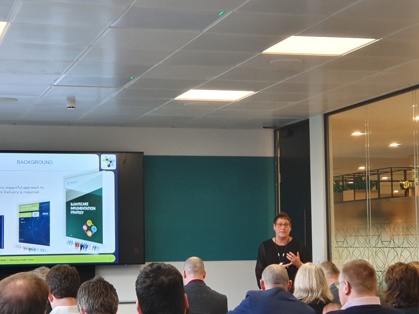
Lilly Walsh - Working agile, alignment with the business
Lilly Walsh presented on agile working and the importance of aligning technology with business of delivering healthcare. Enterprise Architecture’s way of working has evolved from the traditional architecture delivery approach outlined in the ‘Knowledge & Information Strategy to a new way of working where the focus is solely on the customer experience and their evolving requirements. This new way of working provides for a stronger and more cohesive clustering of services and capabilities under the umbrella of product groups which are offered to the Office of CIO. Starting with an organisational, EA will rapidly innovate and iterate architecture developments, empowering collaboration between the different stakeholders, keeping the customer informed at all stages of the development to ensure better business outcomes. Lilly shared with the audience a number of identified architecture challenges to date and then went on to describe one initiative under the Business Optimisation umbrella which aims to provides a central repository of organisational requirements (functional, non-functional, data, interoperability etc.) that is easily accessible to everyone and can be used and reused in the development of different ‘statement of requirements (SoR)’. This development will ultimately shorten the ‘time to market’ phase of a project lifecycle has the potential to lower costs and drive consistency across different projects and programmes.
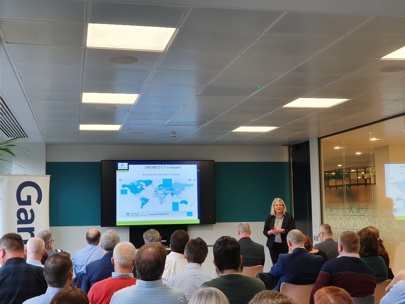
Theresa Barry - Clinical Terminology (SNOMED CT)
Theresa Barry explained that Ireland is now part of the SNOMED International community with its focus on solving the interoperability challenge, SNOMED is a standard and is human readable as well as computer processable. In the era of digital health and electronic health records SNOMED will allow clinicians to configure their terminology across the various services so that the clinical information is recorded, stored and available to retrieve for analysis in a standardised manner. Computers are unable to inform us that various health issues may mean one of the same thing therefor it is up to us to inform them. Across the organisation there is a constant sharing of data from general practitioners to emergency services and hospitals and SNOMED terminology will enable the standardising of sharing this data so that the meaning persists. SNOMED was created by clinicians for patient care use at the point of care and ICD 10 was created by statisticians for secondary care use. Ireland will continue to use ICD 10 for this purpose and SNOMED International have provided us with maps from SNOMED to ICD 10. Theresa and will be working closely with these clinicians to help configure how they can use SNOMED to their advantage.
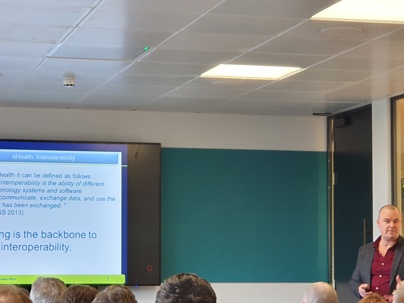
Eamon Coyne - Test & Verification - The Test Harness
Eamon is a technical architecture lead and spoke about the practical use of interoperability, what is meant by eHealth interoperability and the various types. When we have true interoperability it leads to faster access to areas such as patient information, better diagnostics and ultimately better quality of patient treatments. Testing is the backbone of interoperability!. Eamon also spoke about how interoperability tests are carried out and the core capabilities of the platforms used to conduct the tests. He also provided us with some instances where the 'Test Harness' has been applied to date. The Enterprise Architecture team have worked collaboratively with Access to Information colleagues on the automation of testing of the Healthlink Messaging Specifications. Eamon also mentioned Ireland’s recent participation in a 5 week EU test event whereby the goal is to simulate an unscheduled health care encounter for an Irish citizen in need of treatment in another EU member state. In the event, Irish test Patient Summary and ePrescription data was successfully transmitted via the Open National Contact point and subsequently assessed and appraised by Health Care Professionals in 10 other Member States. During this process hundreds of tests were conducted by the Technical Architecture team to achieve this goal. The test Harness can also support Project Managers whereby at the initial project stages the interoperability use cases are identified, specify what initial specifications and standards need to be adhered to and use in the project and subsequently tested via the Test Harness thereafter.
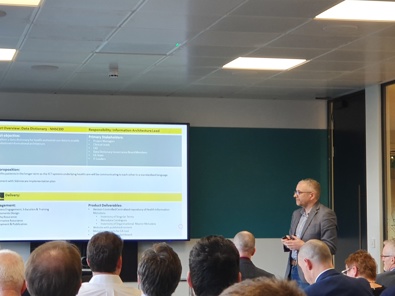
Martin Tully - Data Dictionary Capabilities
Martin Tully gave an overview of the Data Dictionary at a high level and where it fits into the product line model, and how reference sites are used for best practice internationally. An update was also provided on progress made to date and what this means for IT users, service leaders and project managers. The Data Dictionary describes the rules by which all the data in a particular system need to apply by allowing us to better understand all data in the HSE. On the day Martin referred to the vision for it as a shop where customers can go to get the ingredients required to support interoperability and data consistency. If we don’t have rules we cannot expect consistency, we also won’t have comparability. Finally he emphasised that this is an evolving journey and EA are by no means leaders in this field but followers as such countries like Australia, the NHS UK and Malaysia have more developed metadata templates, governance and processes.
The day concluded with an interactive project walk through a demonstration of where exactly you would use particular products within the product lines followed by a Q & A session.
The Enterprise Architecture Team
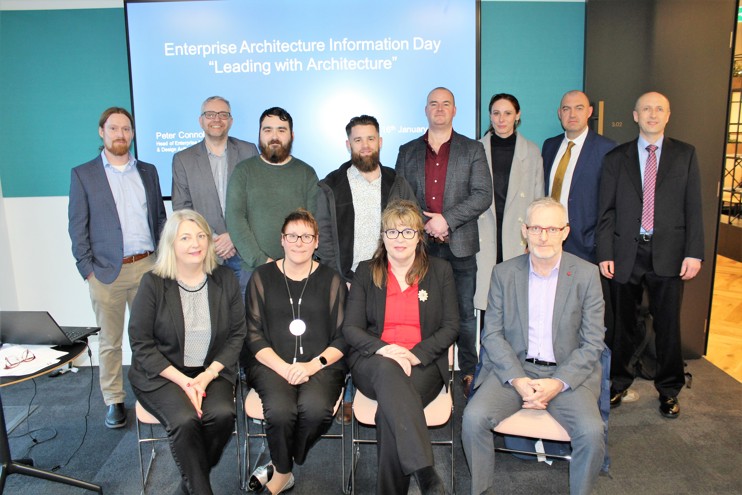
Back row, Left to right = James Moriarty, Martin Tully, Sean Walsh, Ed Harte, Eamon Coyne, Sandra Ryan, Chris Meehan, Peter Connolly
Front row, Left to right = Theresa Barry, Lilly Walsh, Helen Lambert, Chris Plunkett
Please Click On the Links Below to view slide decks from the speakers day
Chris Plunkett Delivery Manager EA.pdf (size 1.1 MB)
Peter Connolly Head of Enterprise Architecture_.pdf (size 1.1 MB)
Lilly Walsh Business Architect EA.pdf (size 2.4 MB)
Theresa Barry Clinical Terminology Architect EA.pdf (size 1.8 MB)
Helen Lambert Compliance Assurance and IG Lead. EA.pdf (size 749.5 KB)
Eamon Coyne Technical Architect.pdf (size 1 MB)
Martin Tully Information Architect.pdf (size 1.2 MB)
Gartner Caroline Barnsdall Thompson Product model.pdf (size 817.1 KB)
Project Lifecycle and Product model EA.pdf (size 41.6 KB)
Information-Day-2020-Stats-11-converted.pdf (size 283.5 KB)
